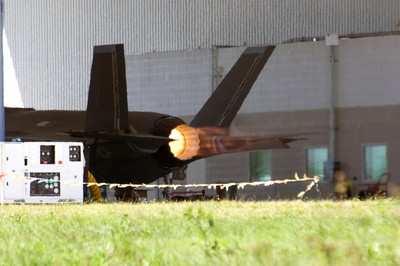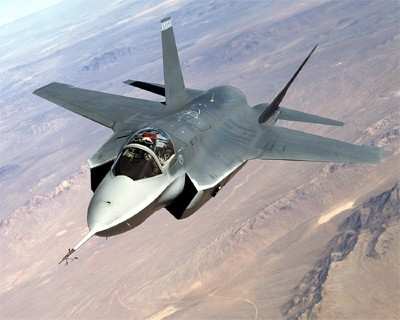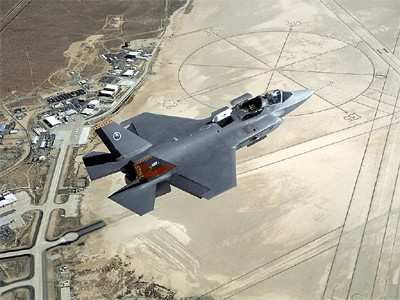 The F-35 Lightning II completed its
first series of engine runs Monday afternoon, culminating in a
full-afterburner test that unleashed 40,000 pounds of thrust
– the most ever from a jet-fighter engine. The testing began
on Friday, Sept. 15, when Chief Pilot Jon Beesley moved a cockpit
switch to the “run” position and brought the Pratt
& Whitney F135 engine to life.
The F-35 Lightning II completed its
first series of engine runs Monday afternoon, culminating in a
full-afterburner test that unleashed 40,000 pounds of thrust
– the most ever from a jet-fighter engine. The testing began
on Friday, Sept. 15, when Chief Pilot Jon Beesley moved a cockpit
switch to the “run” position and brought the Pratt
& Whitney F135 engine to life.
The F-35 Lightning II lights its afterburner during a ground
test at Lockheed Martin in Fort Worth, Texas, on Monday afternoon,
Sept. 18. The Pratt & Whitney F135 engine is the most powerful
engine ever in a jet fighter, producing 40,000 pounds of
thrust.
While F135 engines already have logged thousands of successful
hours on test stands, Friday’s engine start marked the first
time the engine had run in the F-35 aircraft. The milestone kicked
off a final series of ground tests that will lead to the
jet’s first flight later this year.

"This is an exciting time for Pratt & Whitney and the entire
F-35 team," said Bill Gostic, vice president of F135 engine
programs for Pratt & Whitney. "Running this engine in the
aircraft puts us one step closer to watching the F-35 fly. We are
proud that the Lightning II will be powered by Pratt &
Whitney."
“Starting and running the F135 engine means we’re
now in the final stretch leading to first flight, and also that we
have greater insight into the F-35’s design as an integrated
system,” said Dan Crowley, Lockheed Martin executive vice
president and F-35 program manager.
“This team continues to prove that the F-35 is a mature
system that is poised to enter flight test, and soon thereafter,
production.”
A unique Integrated Power Package (IPP), produced by Honeywell
Aerospace Electronic Systems, is used to start the engine. The
installed IPP was started for the first time on Sept. 7. It
combines a starter, electrical power supply and environmental
control system in a single unit – systems that in previous
aircraft have been separate, stand-alone units.
Doug Pearson, vice president of the F-35 Integrated Test Force,
characterized the IPP and engine testing as another example of the
F-35’s ability to integrate teams and complex systems on a
timely basis.

“Previous legacy programs have needed months to progress
from initial onboard power to engine start and full afterburner
mode. The rapid progression on the F-35 is a good indication that
the program’s investments in laboratories and early ground
testing are paying off,” Pearson said.
The engine runs mark the first time that the F-35 has been
completely functional on its own power systems. As the tests
proceeded, Beesley incrementally advanced the throttle until the
engine achieved military power (full power without afterburner) on
Sunday night, and full afterburner on Monday.
Before now, nine F135 development engines had run for more than
5,500 hours on test stands. The F135 is an evolution of the
Pratt & Whitney F119 engine, which powers the F-22 Raptor,
Lockheed Martin’s other 5TH Generation Fighter. Pratt
& Whitney has delivered three flight test engines to support
the F-35's first flights. As the most powerful single-engine
fighter in history, the F-35 Lightning II produces more thrust than
most twin-engine fighters.

The stealthy F-35 is a supersonic, multi-role, 5TH Generation
fighter designed to replace a wide range of existing aircraft,
including AV-8B Harriers, A-10s, F-16s, F/A-18 Hornets and United
Kingdom Harrier GR.7s and Sea Harriers.
Lockheed Martin is developing the F-35 with its principal
industrial partners, Northrop Grumman and BAE Systems. Two
separate, interchangeable F-35 engines are under development: the
Pratt & Whitney F135 and the GE Rolls-Royce Fighter Engine Team
F136. Fifteen F-35s will undergo flight testing, seven will be used
for static/ground testing and another will validate the
aircraft’s radar signature.
 ANN's Daily Aero-Linx (05.04.24)
ANN's Daily Aero-Linx (05.04.24) NTSB Final Report: Quest Aircraft Co Inc Kodiak 100
NTSB Final Report: Quest Aircraft Co Inc Kodiak 100 Aero-News: Quote of the Day (05.04.24)
Aero-News: Quote of the Day (05.04.24) Aero-News: Quote of the Day (05.05.24)
Aero-News: Quote of the Day (05.05.24) Read/Watch/Listen... ANN Does It All
Read/Watch/Listen... ANN Does It All






